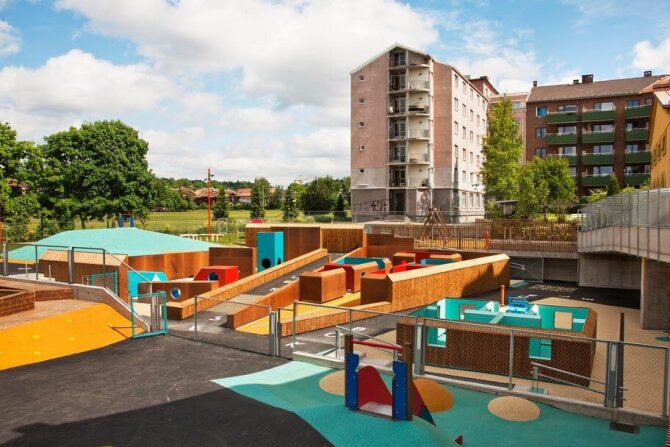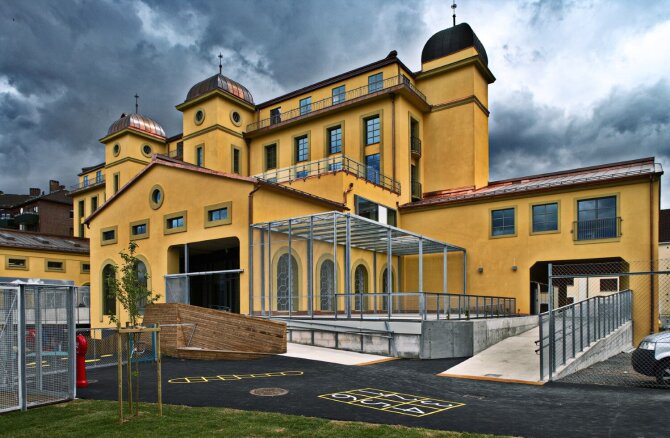Margarinfabrikken Kindergarden
The former margarine factory at Sagene lies in the heart of Oslo and was an exciting choice when Oslo City Council demanded the provision of kindergarden spaces for 500 children. The project was unique in Norway when it came to the size and use of a building which was also on the list of protected buildings. It shows how rehabilitation of existing buildings can achieve universally designed solutions integrated in architecture as a natural part of the original character.
Client: Municipality of Oslo, district Sagene
Developer: Omsorgsbygg Oslo
Contractor: WK Entrepenør
Architect: NAV A.S Arkitekte
Landscape architect: STUDIO hp AS
Consultants: Apeland, The Cultural Heritage Management Office and the Agency of Public Planning
Lead Users:
The Association of the Blind and the Association of the Disabled
Methods:
Dialogue with user organisations, involvement and testing by lead users
Awards:
Category winner Architecture, Innovation Award for Inclusive Design 2011 awarded by Design and Architecture Norway and the Ministry of Children and Inclusion.
5,44
The score on outdoor and indoor environments at Margarinfabrikken with an overall average score for kindergardens in Oslo of 4.85 (Municipality of Oslo, 2013)
CHALLENGE
The main idea from the start was to make the old factory into a space accessible for all, everywhere. This created a challenge in order to maintain the building’s original character. Overall, the project demonstrates how a rehabilitation project can be enhanced by universal design ideas when they are integrated into the design process and the architectural outcomes.
The differences of opinion was many and varied concerning the large, new kindergarden at Sagene. It was a unique and controversial project. A gigantic kindergarden was viewed as both exciting and as a social experiment. However, the renewal of the building for this particular use has been a success. The project was particularly well thought through and has resulted in a light, welcoming kindergarden with good ventilation and acoustics. The project included the old factory originally designed by Thorvald Astrup, and one new building.
One of the greatest challenges was to crack the building code. It was quite a challenge to transform the old factory into a modern building, with an optimal understanding of logistics and function. The building is a noteworthy signal building from 1920, and feature many qualities from the great age of industry. But it was run down and carried the distinctive signs of mechanical production and not of humanity. Now the machines are being removed and the building will become both functional and contemporary for young and old alike.

APPROACH
The structure of the building was in such a sorry state that all old plasterwork had to be removed and the whole interior replastered. The external facade was also improved, before being painted with breathable paint. The original roof was slated and considered unsuitable and a copper roof was installed after additional insulation was laid. Since the main floor lay 1.2 meters above ground level, ramps and bridges had to become part of the functional overall expression to ensure accessible and easy movement for everyone.
Several original details from the building remained and are positive elements in today’s solution, like the high windows and ceilings providing extensive and healthy lighting.
The architects saw that good constructive and positive meetings, close dialogue with the user bodies and organizations such as the Norwegian Association for the Blind and Partially Sighted and the Norwegian Association for the Disabled, the client (Omsorgsbygg), the construction consultant Apeland and the contractors Wegger & Kvalsvik was of high importance. User involvement, including physical testing, was also essential to gain insights leading to optimal solutions both outdoors and indoors.
It was also important to work closely with the landscape architects Studio hp who were responsible for the outdoor design. This area was very demanding, but they succeeded through a continuation of the base and zone organization, while all areas were open and inclusive.
Extensive use of rubber to prevent fall injuries was a solution which provided safe constraints. The material was also good for playing with colours for other exterior surface flooring. In addition to providing a space to be used by such a large number of children, the specifications also demanded that the area should be open as a park for the public when the kindergarden was closed, and had to be taken into account in the design phase.
When calculating the space requirements for the children they took into consideration that about half the children would be over three years of age and the rest would be under three. The youngest children require more space per person. Between the two buildings at the Margarinfabrikken kindergarden there is space for 600 children, but it was agreed with the Planning and Development office that an operational capacity of 540 children and 140 adults would be tested.
The structure of a potentially chaotic macro cosmos into a manageable micro cosmos was solved through a division of defined zones making the distribution of children clear and not overwhelming at all. There is plenty of room for every child with access to a playground arranged to create good motivation for stimulating play and learning based on modern educational principles.

RESULTS
The protected margarine factory has been converted into a pedagogically innovative kindergarden. The spatial qualities of the existing building have been utilised, and the original column structure proved flexible enough for new functional solutions, allowing a number of new types of activities for the children. On the adjoining site a new extension in steel and concrete, with a timber facade, helps screen the outdoor play areas from the road.
The outdoor play areas are organised around the same elements as the surrounding city – houses, streets and squares as well as labyrinths and gardens. Each group of children have a home area, a base from which they can venture out and explore the more public themed rooms and places.
Ramps and bridges is part of the functional overall expression to ensure accessible and easy movement for everyone, and the indoor and outdoor areas are all developed with a variety of children and needs in mind.
One special opportunity in creating a kindergarden is the freedom to play with colours. Universal design as a visual tool is integral to the holistic solutions of Margarinfabrikken. The kindergarden houses 30 bases, each with 24 children and the entranceways to the bases have special markings in a variety of colours and different materials. Folios on doors, windows and surroundings create good contrast and pictographic symbols shows the way. The graphic design follows a logical interior division in which colours and graphics function as visual coding for the various departments. The graphic elements across pillars and walls also function as a guide. Contrast-rich colour schemes in a harmonious palette give identity to the various zones and underline their use, as well as providing orientation for the visually impaired. End walls also generate contrasts, as does coloured lighting.
Universal design is not something to be worked around, but needs to be an integral part of the idea. It is simply a matter of solving it, not letting the challenge become a problem. It goes without saying that inclusivity is a central notion in most projects now. The responsibility given by the council in individual projects is tied to the interpretation and understanding of the regulations.
Despite the predictions and scepticism of a giant kindergarden, a survey by the Municipality of Oslo three years after the opening showed a pre-dominantly positive experience in practical use. The users represented by their parents gave the kindergardens of Oslo an overall score of 5,12. The total score for the five largest kindergardens in the city was 5.0 where the Margarinfabrikken’s old building stands out positively. The kindergarden also got 5.44 in score on outdoor and indoor environments, while the Oslo average was 4,85.
